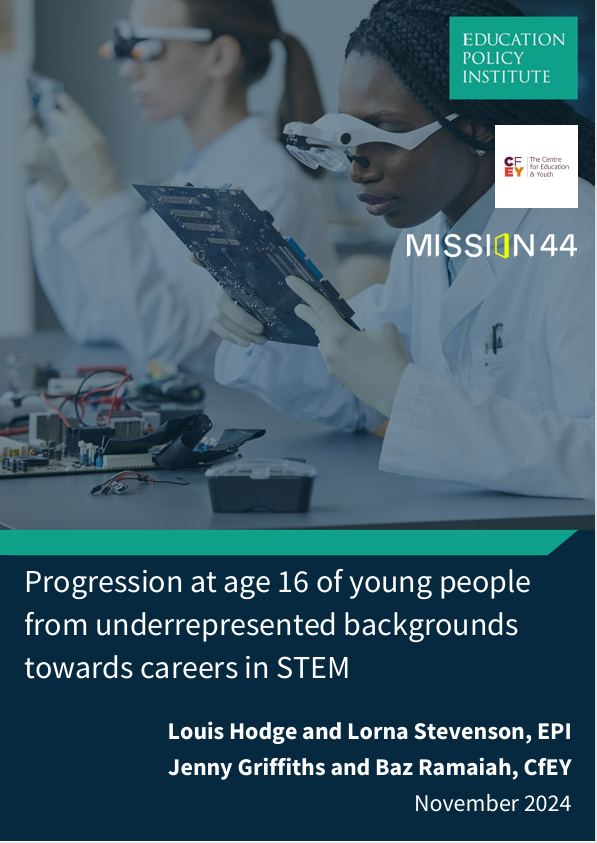A new report by the Education Policy Institute (EPI) and the Centre for Youth and Education (CfEY), supported by Mission 44, highlights the need for targeted efforts to increase post-16 participation in STEM subjects for currently underrepresented groups.
Drawing on quantitative and qualitative analyses, this report examines why some groups of students, in particular those from disadvantaged backgrounds, by gender, and different ethnicities are less likely to pursue STEM subjects post-16. The research covers three distinct but linked strands of work:
1. An exploration of the existing evidence on why some pupil groups are underrepresented on post-16 STEM courses. We describe a ‘three Ps’ model (pathway, prior qualifications, and preferences) to explain the factors that contribute to a pupil pursuing a level 3 STEM qualification.
2. Analysis of administrative data to establish patterns of progression by pupil and school characteristics, as well as identifying school-level effects on pupils’ likelihood of progressing to STEM related courses post-16.
3. The findings from interviews and focus groups conducted with school leaders, teachers, and students on the key enablers and barriers underrepresented groups face, such as prior attainment, limited local STEM opportunities, and a lack of awareness about STEM careers.
The report finds that:
-
- The odds of progressing to level 3 STEM after leaving secondary school are 44% lower for disadvantaged pupils compared to their more affluent peers. Pupils that are ethnically Black Caribbean, White and Black Caribbean, Gypsy/Roma, and Travellers of Irish heritage are amongst the least likely to progress to level 3 STEM qualifications.
- Disadvantaged pupils and pupils from certain ethnic backgrounds are particularly hindered by lower average GCSE attainment. The difference in progressing to level 3 STEM between pupils on free school meals and their more affluent peers almost disappears if they have similar attainment, whilst Black Caribbean pupils are estimated to be 40% more likely to progress to level 3 STEM qualifications than White British pupils with similar attainment.
- The odds of progressing to level 3 STEM qualifications after leaving secondary school are 42% lower for girls, compared to boys. Though prior attainment masks the size of the gender gap – girls are 60% less likely to progress to level 3 STEM qualifications than boys with similar attainment – with preferences playing a larger factor.
- The school attended plays a modest role in determining pupils’ likelihood of progressing to level 3 STEM, though this is more pronounced for some groups such as: girls compared to boys; for disadvantaged compared to non-disadvantaged pupils; and for all major ethnicity groups compared to White pupils.
- Prior attainment is linked to perceptions of subject interest, as students were more likely to express a preference for subjects that they saw themselves as being successful in. Pupils also made a link between their option choices and perceived teacher quality, or in some cases simply the availability of specialist teachers.
- In many school settings STEM routes are found to be limited to traditional A level academic routes with prior attainment entry barriers. There is often a lack of clear pathways to post-16 STEM qualifications for ‘middle attainers’.
Recommendations:
-
- The curriculum and assessment review should consider how access to non-A level post-16 STEM qualifications can be improved, including how to fill gaps in local provision. Routes to level 3 STEM qualifications are generally quite limited to traditional A level academic routes with prior attainment entry barriers.
- The government should develop a renewed strategy for closing the disadvantage gap which acts as a barrier to accessing level 3 STEM subjects. This should include the adequacy of disadvantage funding across all phases and the introduction of a student premium for those studying in post-16. Low prior attainment is a particular barrier preventing more disadvantaged pupils progressing to level 3 STEM. We know that by the end of secondary school disadvantaged pupils are, on average, 19 months of learning behind their peers.
- The government should ensure the sufficient supply of specialist teachers in secondary schools by increasing retention through differentiated pay. Pupils’ preferences for further study in a field are influenced by their current teachers. In 2023/24 the government only met 17% of its recruitment target for physics teachers, 36% for computing and 63% for maths teachers.
- Careers leaders should continue to work with careers advisers and hubs to provide employer experiences that offer ‘real world’ examples of what it is like to work in STEM jobs in practice, particularly focusing on representation from currently underrepresented groups. Students often do not have a good understanding of the wide range of STEM career opportunities and improving awareness of the courses and routes that are available will likely increase participation.
You can download and read the full report here.
This report has been kindly funded by Mission 44.


